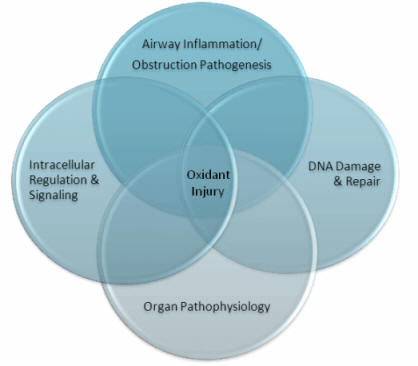Training Areas

We provide training in four areas: airway inflammation/obstruction pathogenesis, intracellular regulation and signaling, DNA damage and repair, and organ pathophysiology, which share a unifying theme of oxidant injury as shown in Figure 1. Each of these areas has clusters of faculty who address complementary research questions and engage in regular interactions, who have ready access to abundant resources and instrumentation in Center, Institutional, and Departmental research facilities, and who have a track record of successfully training our current and former NIEHS fellows.
Major Goal of Our Training Program
The goal of the UTMB training program in Environmental Toxicology, for graduate students and postdoctoral fellows, continues to be to provide young scientists with the knowledge base, technical expertise, and professional skills that each will need to advance the state of knowledge concerning the mechanistic basis of injury by environmental agents.
Specific Goals of Our Training Program
- Provide exemplary and exceptional opportunities for research training
by fostering translational teams of interdisciplinary collaborations on questions relevant to environmental toxicology, among a dedicated body of scientists who have complementary expertise and interests.
- Offer an attractive, challenging curriculum that will provide trainees with the knowledge base needed to understand: a) how toxicants interact with biological systems; and b) mechanistic aspects of the processes that evoke the subsequent detrimental consequences. Thus, trainees will be prepared to advance our understanding about critical issues such as oxidant disruption of protein integrity and the polymorphisms that render certain population groups more vulnerable to toxicant-induced disease.
- Augment laboratory and didactic training by program activities that develop the professional skills needed for advancement towards an independent career. Particular emphasis will be given to communication skills and to constructive experiences for teaching, paper writing and review, and grant preparation.
- Instill a wider appreciation for environmental issues through our journal clubs, seminars by local and visiting scientists, and opportunities to interact with experts in regulatory, legal, health policy, and risk assessment aspects of toxicology.
- Raise awareness about environmental toxicology research at UTMB in order to attract highly qualified students, help each find both a mentor and a network of additional faculty support, and then systematically monitor their progress to ensure that each receives first-rate training in the conduct of an independent research project.